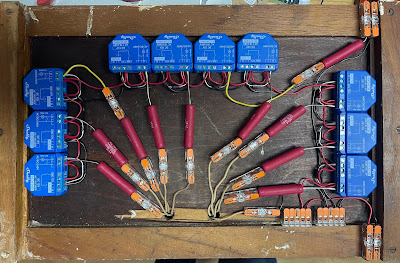But if we did, we'd need one of these beauties.
Well, the plan is to make this work for a friend of mine.
Believe it or not, it is "electric". With bare wires nailed to a board, and coils! With a bit of cleaning up and soldering, I have all the coils working.
With a bit of experimentation I could see how to drive this. I think I can even use what remains of the original wires which go round the back where they were just cut off. Basically the coils pull the swinging indicator, and on release it is left swinging back and forth. Oddly there is no sort of sounder, so I wonder how it worked to get people's attention. I'm planning an additional bell.
So, how to drive it - well it looks like a suitable resistor will allow it to work quite easily on a 12V supply, with a back EMF diode.
Relay board
One simple solution is an off the shelf relay board. Like I used for my DEFCON lights. One small snag is that they come with 8 relays and this needs 9 (10 if you include the bell).
Definitely a possibility though.
Custom board
Another simple enough idea is I make a relay board with 10 outputs. PCBTrain can turn these around in a day, and it may be a nice useful board design. I'm in two minds whether to use a relay, a solid state relay, or a driver (that drives 0V/12V). All could handle the approx 1A needed, especially as it would be a short pulse. I need to think about the other uses of these as part of the design, obviously.
The drivers are nice in that they take a lot less space, but are not as flexible as they drive the output rather than simply being an effective relay contact.
I also have to think how I make one of these - as almost all the chips I would use are on something like a year lead time! Thankfully I have several solid state relays and several driver chips in stock, and enough power supplies.
I could, of course, take the opportunity to consider using the newer ESP32-S2 modules, which seem to be available. This would all make this more of an R&D project, which is not a bad idea.
It would all take time though, and I am quite keen to have this ready for Christmas.
Shelly
There is, of course, a simple answer, and ironically likely to be the cheapest, and that is just use a Shelly1 relay module. Even needing 10 of them is not expensive, and there is space on the back of this thing. They are available and in stock for next day.
This does feel like cheating somewhat but may be the best option. Certainly worth prototyping with one of them to start with.
Then what?
One way or another I'll end up with WiFi connected indicators. So we need a way for that to work from places around the house. Buttons, or a pull cord, etc.
For this, by far the simplest is the Shelly option, as a light switch, sending an MQTT message when pressed.
P.S. Blogger is broken again, even with clearing caches, and so I cannot actually reply to comments!
P.P.S. I went with Shelly Plus 1, but my own code...







What happens if you drive the coil with AC? Could be that the whole thing acts as a sounding board and makes a suitable buzzing noise?
ReplyDeleteI've got one of these in the loft I think - if you want it you can have it.
ReplyDeleteIt was a spare at our old house (when I was a kid) which was a big Victorian place - the buzzers still worked there. Ran off an old AC transformer so the box buzzed the alert and then by the time you got to it the flag was still 'waving' which showed which one had buzzed.
We had much the same and yes, there was a buzzer.
DeleteSurely simpler to replace with a LCD display and a speaker to make the bell noise?
ReplyDeleteIf you want a physical switch to signal to MQTT, Ikea "Tradfri shortcut buttons" are worth a look. Cheap, portable, long battery life and work well with a Zigbee dongle on a Raspberry Pi.
ReplyDeleteI wonder if whoever made that could even conceive what you have just done to it!
ReplyDelete